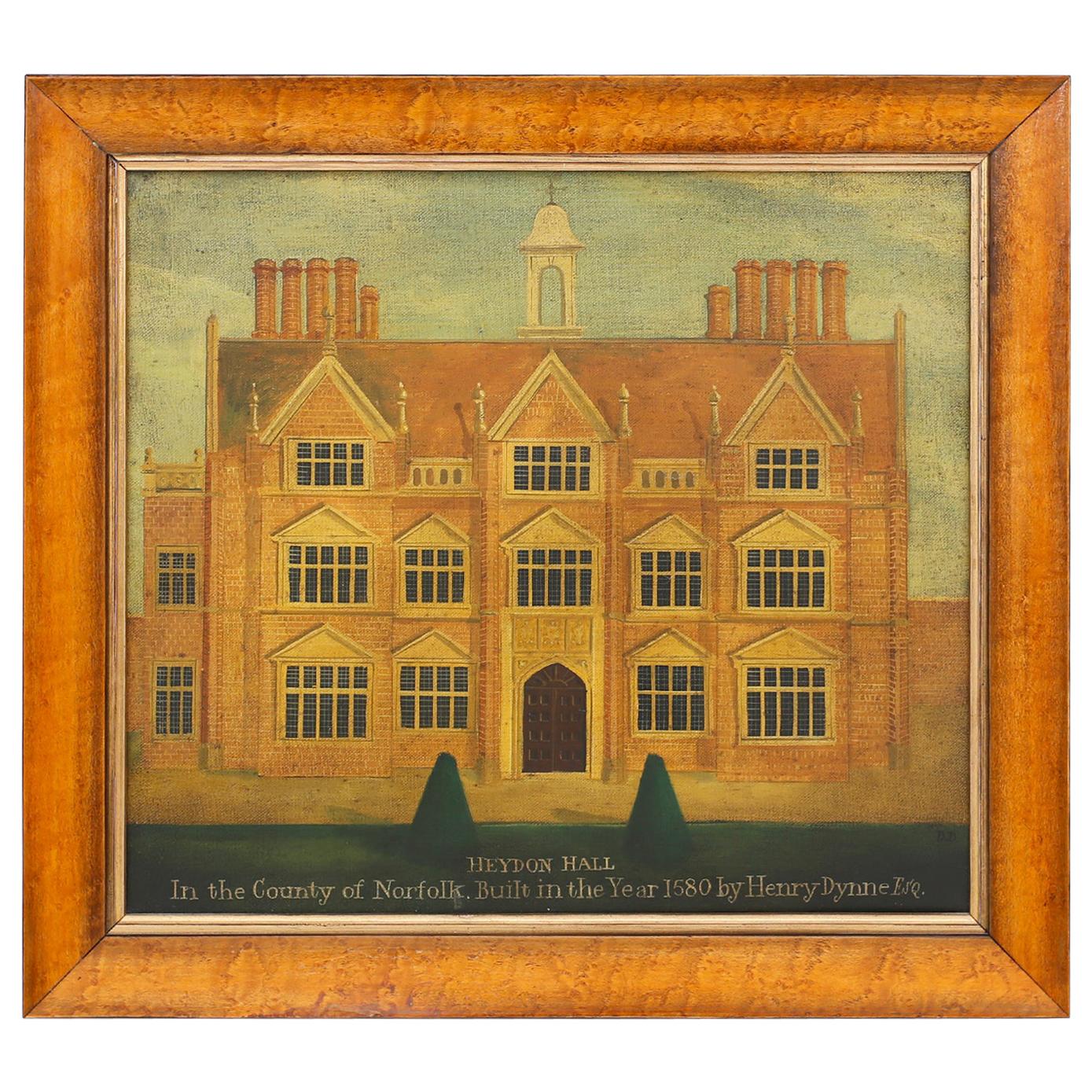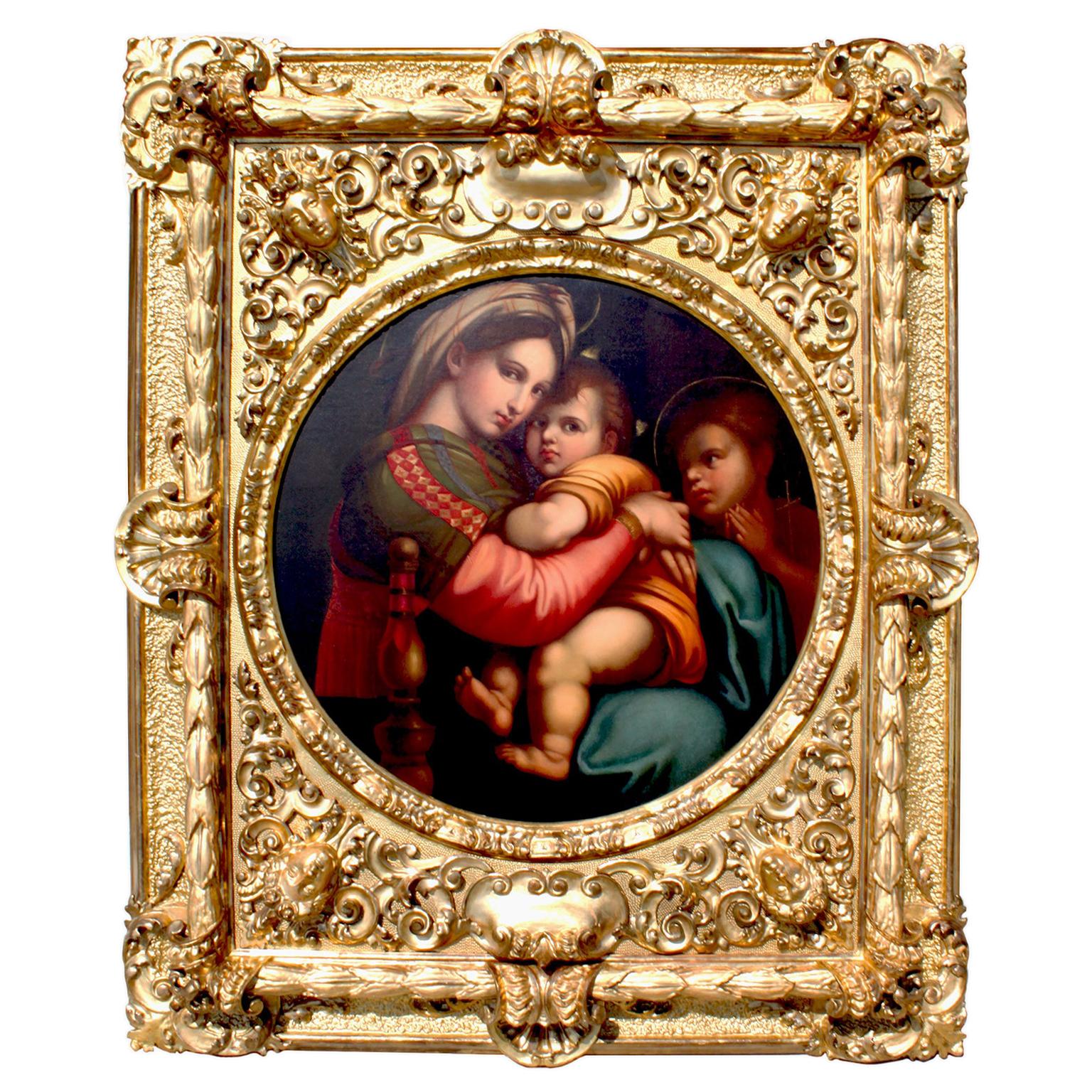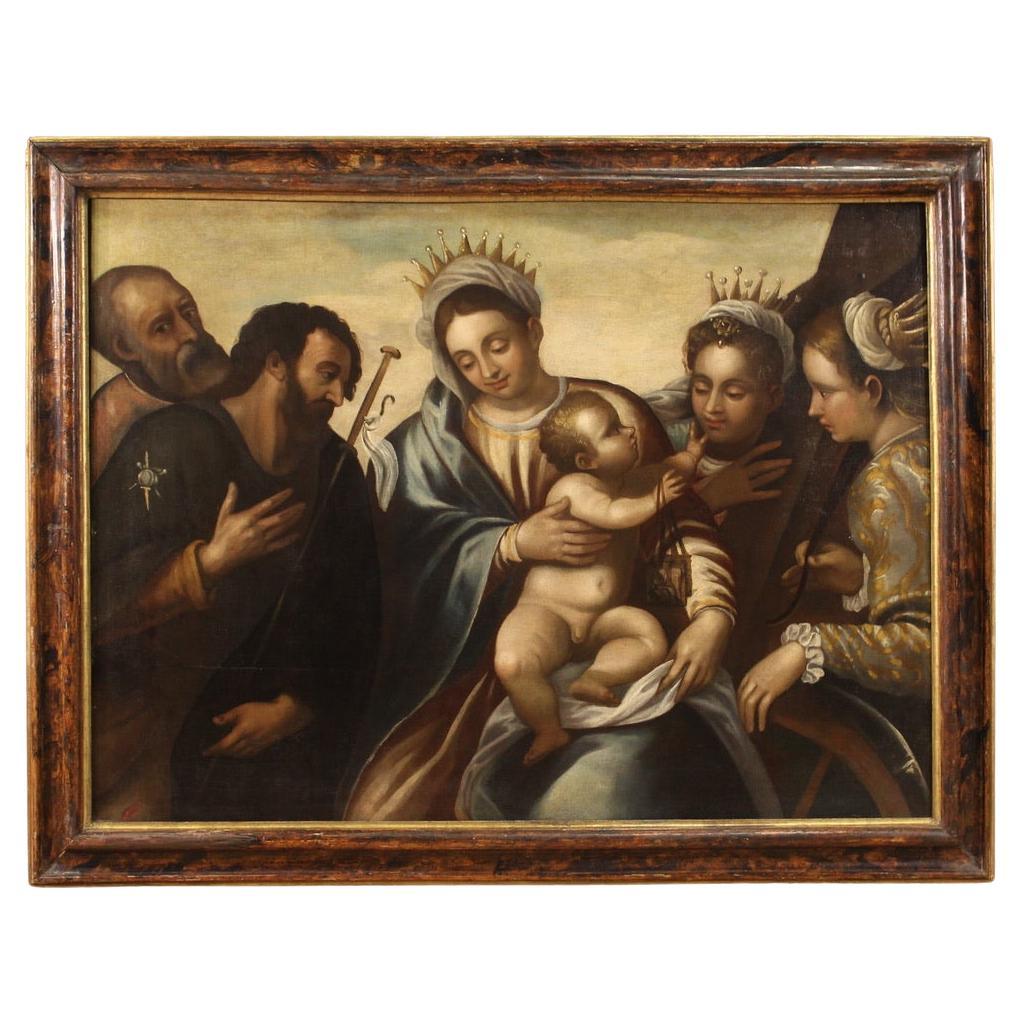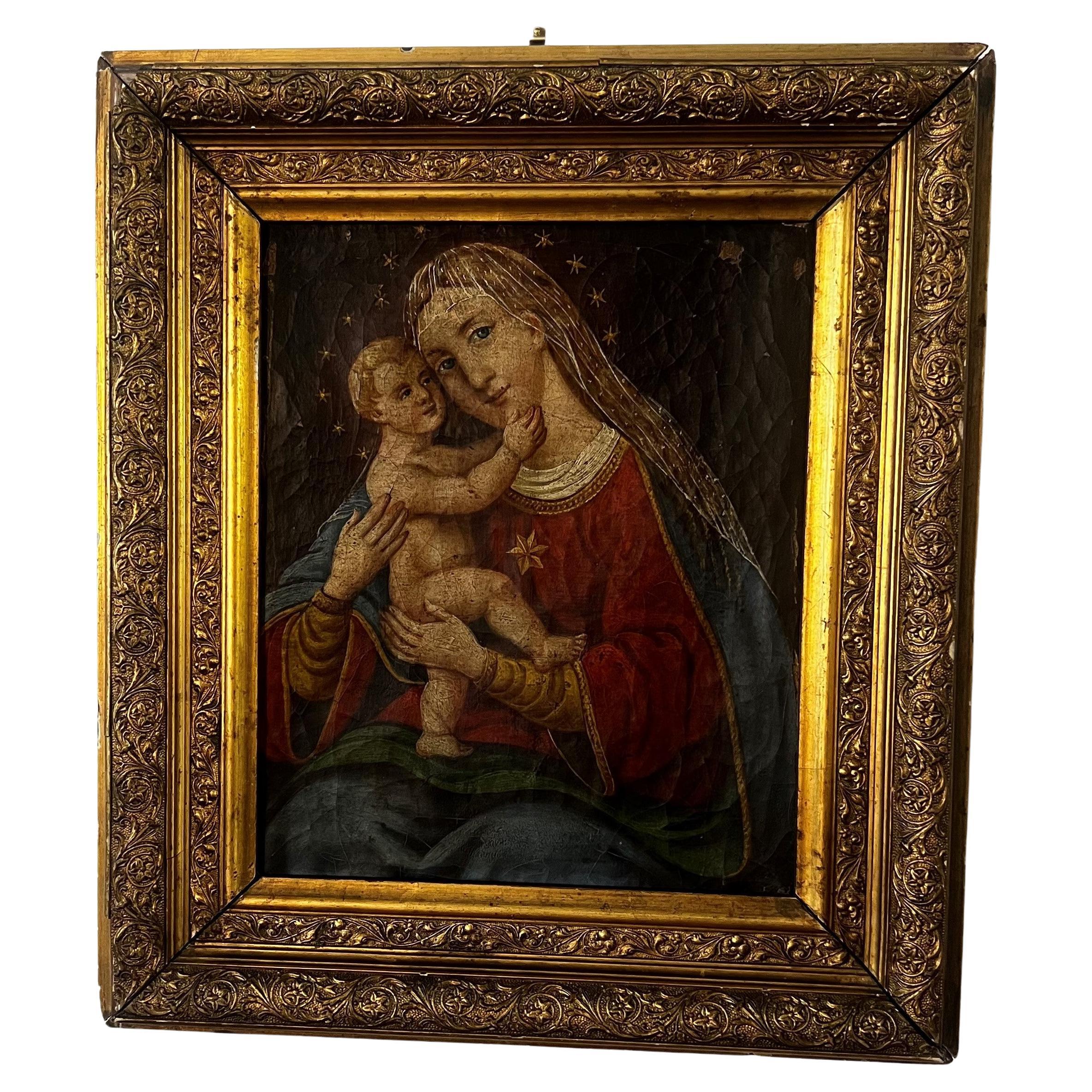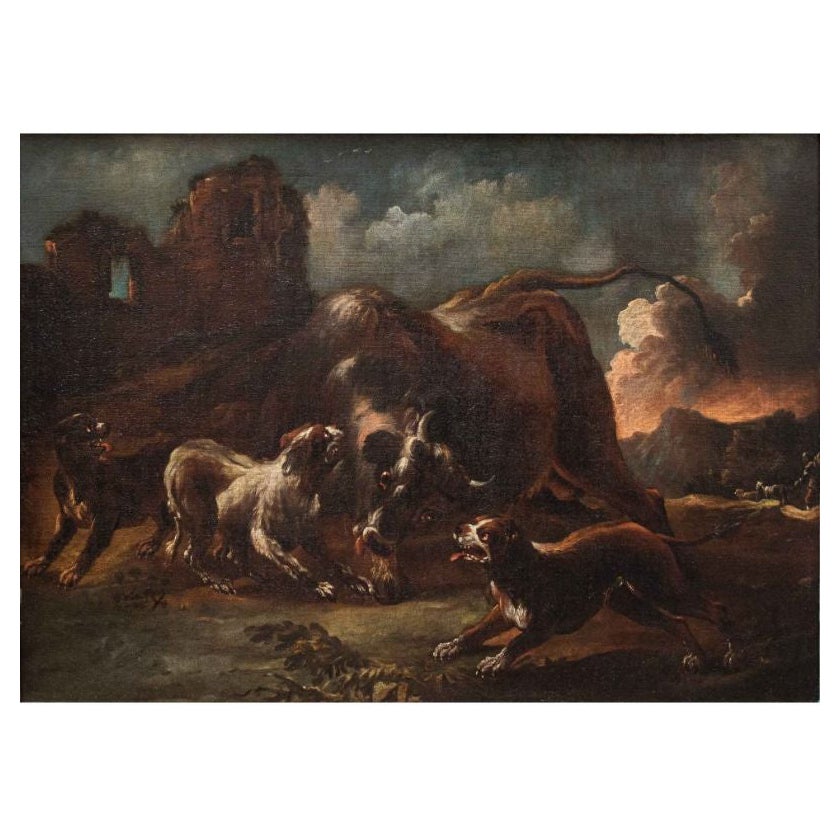Items Similar to 16th Century Madonna of the Carnations Painting Oil on Canvas from Raffaello
Want more images or videos?
Request additional images or videos from the seller
1 of 13
16th Century Madonna of the Carnations Painting Oil on Canvas from Raffaello
About the Item
16th century, by Raffaello Sanzio (Urbino, 1483 - Rome, 1520)
Madonna of the Carnations
Measures: Oil on canvas 38 x 30 - with frame 59 x 52.5 cm
The Madonna dei Garofani made by Raffaello Sanzio (Urbino, 1483 - Rome, 1520) has become a very successful iconographic model and has many replicas, such as the one examined here.
The Raphaelesque original, now exhibited at the National Gallery in London, was made between 1503 and 1507, when the painter was about 23 years old. The London specimen has been identified as the original and there are about fifty copies of it as evidence of the great success achieved among the clients (Madonna di Siracursa, Madonna Chatron; there is also a copy made by Federico Barocci - Galleria Borghese). Influence on Raphael by Leonardo da Vinci and, in particular, of the Benois Madonna (Hermitage Museum, St. Petersburg). The sacred image also owes its diffusion to the numerous engravings that circulated from shop to shop.
Raphael's painting is a religious work intended for private devotion. Raphael manages to transform the classic subject of the Madonna and Child into a representation with a familiar tone. The young mother and her son are no longer depicted in rigid and formal poses, as in the paintings of previous artists, but have abandoned all formality, letting themselves go into a tenderly intimate attitude and letting all the emotions of their relationship shine through. The Madonna exchanges with Jesus some small red carnations which represent by their color the blood that Jesus will shed in the future on the cross (according to tradition, the carnation is considered a symbol of divine love and it is believed that it blossomed from the earth where the tears of the Virgin during the Passion of Christ.). Furthermore, they also refer to the marriage between Christ and the universal Church represented by Mary. Finally, the four-poster bed symbolizes the virginity of the Madonna.
This replica, to be dated to the 16th century, was created by an artist familiar with the Raphaelesque original, an image that spread mainly through engravings. The entire composition is overturned with respect to the autographed copy, but here too the Virgin and Child Jesus are in a room immersed in the shade. Maria wears a pink dress (in the original gray) decorated on the sleeves with puffed motifs. In addition, she wears on her legs the blue cloak on which the white pillow rests. The Child, on the other hand, is naked (even if a soft cloth cores his nakedness) and sits on the legs of the Mother and observes the flowers that he holds in her hands. Inside there is a canopy bed and from the window you can glimpse a countryside landscape with some ruins.
- Similar to:Raphael (Raffaello Sanzio da Urbino) (Painter)
- Dimensions:Height: 23.23 in (59 cm)Width: 20.87 in (53 cm)Depth: 1.58 in (4 cm)
- Materials and Techniques:
- Place of Origin:
- Period:
- Date of Manufacture:16th Century
- Condition:Refinished. Wear consistent with age and use. The painting has been cleaned.
- Seller Location:Milan, IT
- Reference Number:1stDibs: LU5918229644822

About the Seller
5.0
Vetted Seller
These experienced sellers undergo a comprehensive evaluation by our team of in-house experts.
Established in 2000
1stDibs seller since 2021
25 sales on 1stDibs
Typical response time: 12 hours
- ShippingRetrieving quote...Ships From: Milan, Italy
- Return PolicyA return for this item may be initiated within 14 days of delivery.
More From This SellerView All
- 16th Century Animals Painting Oil on Canvas by CrivellinoLocated in Milan, ITGiovanni Crivelli known as Crivellino (Milan,? - Parma, 1760) Fight between dogs and bison Oil on canvas, 84 x 111 cm With frame 112 x 139 cm Thanks to the comparison with h...Category
Antique 16th Century Italian Paintings
MaterialsCanvas
- 16th Century Adoration of The Shepherds Painting Oil on CopperLocated in Milan, ITAttr. to Girolamo Siciolante known as da Sermoneta (Sermoneta, 1521 - Rome, 1575) Adoration of the Shepherds Oil on copper, 39 x 29.5 cm Frame 47 x 39 cm The refined taste, the refined poses, the definition of the anatomies, the vibrant light, allow us to identify for this painting the hand of a Mannerist painter active during the sixteenth century. In particular, the composition and stylistic research allow us to attribute the panel to Girolamo Siciolante, known as da Sermoneta (1521 - 1575). His first training took place under the guidance of Leonardo Grazia known as da Pistoia (1502 - 1548). Later he settled in Rome where he was able to see the painting of Raphael and Michelangelo from life and where he was first a pupil and then a collaborator of Perin del Vaga...Category
Antique 16th Century Italian Paintings
MaterialsCopper
- 16th Century Adoration of the Shepherds Painting Oil on Copper by CarnevaleBy Carnevale StudioLocated in Milan, ITDomenico Carnevale (Sassuolo, 1524 - Modena, 1579) Adoration of the Shepherds Oil on copper, 42 x 28 cm Frame 54 x 36 cm Expert opinion of Prof. Emilio Negro The painting represents the Adoration of the Shepherds, the Child in the center, next to the Madonna kneeling in prayer and an angel behind her; towards him in the foreground a woman with a child in her arms, a shepherd with a sheep on the right, a bagpiper on the left and various other male and female characters turn to him. The architectures of the background, between which a glimpse of the landscape can be glimpsed, are hidden in the upper part by the clouds, where a "celestial glory" encamps with three flying angels. The painting shows mannerist characters that can be traced back to the second half of the sixteenth century, and can be traced back to an author from the Modena area, with stylistic references to the Bolognese Samacchini (1532 - 1577) and Passerotti (1529 - 1592). More precisely, it can be attributed to Domenico Carnevale (1524-1579), one of the most important masters of the sixteenth century active in the local area. The Carnival was formed in Emilia, his homeland, where he worked for many years. However, his works also show a clear Roman influence, dictated by a long experience in the city, during which he also dedicated himself to the restoration of the Sistine Chapel. Trained in the late-mannerist environment of Modena, he is also linked to the Parmesan Corrorese and Ferrarese Dossesque tradition; Carnival also always maintains a slight archaic sentiment in his work, The main stylistic reference must be identified in a work similar in subject and iconographic setting, coming from the church of the Pio Istituto Orfanelle di San Geminiano di Modena, currently part of the Art Collection of the Province, attributed to the same influence as the Carnival. Another interesting comparison should be identified with A Presentation of Jesus in the Temple...Category
Antique 16th Century Italian Paintings
MaterialsCopper
- Mannerist painter, Leda and the Swan, Oil on canvas, 16th centuryLocated in Milan, ITMannerist painter, 16th century Leda and the Swan Oil on canvas, 87.5 x 142 cm Initial 'P' in center of pillow embroidery Leda, queen of Sparta and bride of Tindarus, is lying on...Category
Antique 16th Century Paintings
MaterialsCanvas
- 17th Century Madonna of the Milk Painting Oil on PanelLocated in Milan, IT17th century Madonna of the milk Oil on panel, 27 x 20 cm - with frame 32.5 x 26 cm The subject of the work in question is particularly fascinating for its sweetness and refinem...Category
Antique 17th Century Italian Paintings
MaterialsWood
- 16th-17th Century Gentleman’s Portrait Oil on Canvas by Francesco ZuccoLocated in Milan, ITFrancesco Zucco (circa 1575-1627) Gentleman’s portrait Measures: Oil on canvas, cm 120 x 140 The painting analyzed here belongs to the pictorial production of Francesco Zucc...Category
Antique Early 17th Century Paintings
MaterialsCanvas
You May Also Like
- Oil Painting on Canvas of a 16th Century BuildingLocated in Palm Beach, FLArchitectural oil painting on canvas of Heydon Hall executed in a rustic naive style with contrived aging and presented in a maple frame. Signed Dan Dunton.Category
20th Century English Folk Art Paintings
MaterialsPaint
- After Raffaello Sanzio 1483-1520 Raphael La Madonna della Seggiola Oil on CanvasBy Raphael (Raffaello Sanzio da Urbino)Located in Los Angeles, CAA fine Italian 19th century oil painting on canvas "La Madonna della Seggiola" after Raphael (Raffaello Sanzio da Urbino 1483-1520) The circular canvas depicting a seated Madonna holding an infant Jesus Christ next to a child Saint John the Baptist, all within a massive carved gilt wood and gesso frame (all high quality gilt is original) which is identical to the frame on Raphael's original artwork. This painting is a 19th Century copy of Raphael's Madonna della Seggiola painted in 1514 and currently exhibited and part of the permanent collection at the Palazzo Pitti, Galleria Palatina, Florence, Italy. The bodies of the Virgin, Christ, and the boy Baptist fill the whole picture. The tender, natural looking embrace of the Mother and Child, and the harmonious grouping of the figures in the round, have made this one of Raphael's most popular Madonnas. The isolated chair leg is reminiscent of papal furniture, which has led to the assumption that Leo X himself commissioned the painting, circa 1890-1900. Subject: Religious painting Measures: Canvas height: 29 1/4 inches (74.3 cm) Canvas width: 29 1/4 inches (74.3 cm) Painting diameter: 28 1/4 inches (71.8 cm) Frame height: 57 7/8 inches (147 cm) Frame width: 45 1/2 inches (115.6 cm) Frame depth: 5 1/8 inches (13 cm). Raffaello Sanzio da Urbino (Italian, March 28 or April 6, 1483 - April 6, 1520), known as Raphael, was an Italian painter and architect of the High Renaissance. His work is admired for its clarity of form, ease of composition, and visual achievement of the Neoplatonic ideal of human grandeur. Together with Michelangelo and Leonardo da Vinci, he forms the traditional trinity of great masters of that period. Raphael was enormously productive, running an unusually large workshop and, despite his death at 37, leaving a large body of work. Many of his works are found in the Vatican Palace, where the frescoed Raphael Rooms were the central, and the largest, work of his career. The best known work is The School of Athens in the Vatican Stanza della Segnatura. After his early years in Rome much of his work was executed by his workshop from his drawings, with considerable loss of quality. He was extremely influential in his lifetime, though outside Rome his work was mostly known from his collaborative printmaking. After his death, the influence of his great rival Michelangelo was more widespread until the 18th and 19th centuries, when Raphael's more serene and harmonious qualities were again regarded as the highest models. His career falls naturally into three phases and three styles, first described by Giorgio Vasari: his early years in Umbria, then a period of about four years (1504–1508) absorbing the artistic traditions of Florence, followed by his last hectic and triumphant twelve years in Rome, working for two Popes and their close associates. Raphael was born in the small but artistically significant central Italian city of Urbino in the Marche region, where his father Giovanni Santi was court painter to the Duke. The reputation of the court had been established by Federico III da Montefeltro, a highly successful condottiere who had been created Duke of Urbino by the Pope - Urbino formed part of the Papal States - and who died the year before Raphael was born. The emphasis of Federico's court was rather more literary than artistic, but Giovanni Santi was a poet of sorts as well as a painter, and had written a rhymed chronicle of the life of Federico, and both wrote the texts and produced the decor for masque-like court entertainments. His poem to Federico shows him as keen to show awareness of the most advanced North Italian painters, and Early Netherlandish artists as well. In the very small court of Urbino he was probably more integrated into the central circle of the ruling family than most court painters. Federico was succeeded by his son Guidobaldo da Montefeltro, who married Elisabetta Gonzaga, daughter of the ruler of Mantua, the most brilliant of the smaller Italian courts for both music and the visual arts. Under them, the court continued as a centre for literary culture. Growing up in the circle of this small court gave Raphael the excellent manners and social skills stressed by Vasari. Court life in Urbino at just after this period was to become set as the model of the virtues of the Italian humanist court through Baldassare Castiglione's depiction of it in his classic work The Book of the Courtier, published in 1528. Castiglione moved to Urbino in 1504, when Raphael was no longer based there but frequently visited, and they became good friends. He became close to other regular visitors to the court: Pietro Bibbiena and Pietro Bembo, both later cardinals, were already becoming well known as writers, and would be in Rome during Raphael's period there. Raphael mixed easily in the highest circles throughout his life, one of the factors that tended to give a misleading impression of effortlessness to his career. He did not receive a full humanistic education however; it is unclear how easily he read Latin. Early Life and Works His mother Màgia died in 1491 when Raphael was eight, followed on August 1, 1494 by his father, who had already remarried. Raphael was thus orphaned at eleven; his formal guardian became his only paternal uncle Bartolomeo, a priest, who subsequently engaged in litigation with his stepmother. He probably continued to live with his stepmother when not staying as an apprentice with a master. He had already shown talent, according to Vasari, who says that Raphael had been "a great help to his father". A self-portrait drawing from his teenage years shows his precocity. His father's workshop continued and, probably together with his stepmother, Raphael evidently played a part in managing it from a very early age. In Urbino, he came into contact with the works of Paolo Uccello, previously the court painter (d. 1475), and Luca Signorelli, who until 1498 was based in nearby Città di Castello. According to Vasari, his father placed him in the workshop of the Umbrian master Pietro Perugino as an apprentice "despite the tears of his mother". The evidence of an apprenticeship comes only from Vasari and another source, and has been disputed—eight was very early for an apprenticeship to begin. An alternative theory is that he received at least some training from Timoteo Viti, who acted as court painter in Urbino from 1495.Most modern historians agree that Raphael at least worked as an assistant to Perugino from around 1500; the influence of Perugino on Raphael's early work is very clear: "probably no other pupil of genius has ever absorbed so much of his master's teaching as Raphael did", according to Wölfflin. Vasari wrote that it was impossible to distinguish between their hands at this period, but many modern art historians claim to do better and detect his hand in specific areas of works by Perugino or his workshop. Apart from stylistic closeness, their techniques are very similar as well, for example having paint applied thickly, using an oil varnish medium, in shadows and darker garments, but very thinly on flesh areas. An excess of resin in the varnish often causes cracking of areas of paint in the works of both masters. The Perugino workshop was active in both Perugia and Florence, perhaps maintaining two permanent branches. Raphael is described as a "master", that is to say fully trained, in December 1500. His first documented work was the Baronci altarpiece for the church of Saint Nicholas of Tolentino in Città di Castello, a town halfway between Perugia and Urbino. Evangelista da Pian di Meleto, who had worked for his father, was also named in the commission. It was commissioned in 1500 and finished in 1501; now only some cut sections and a preparatory drawing remain. In the following years he painted works for other churches there, including the Mond Crucifixion (about 1503) and the Brera Wedding of the Virgin (1504), and for Perugia, such as the Oddi Altarpiece. He very probably also visited Florence in this period. These are large works, some in fresco, where Raphael confidently marshals his compositions in the somewhat static style of Perugino. He also painted many small and exquisite cabinet paintings in these years, probably mostly for the connoisseurs in the Urbino court, like the Three Graces and St. Michael, and he began to paint Madonnas and portraits. In 1502 he went to Siena at the invitation of another pupil of Perugino, Pinturicchio, "being a friend of Raphael and knowing him to be a draughtsman of the highest quality" to help with the cartoons, and very likely the designs, for a fresco series in the Piccolomini Library in Siena Cathedral. He was evidently already much in demand even at this early stage in his career. Influence of Florence Raphael led a "nomadic" life, working in various centres in Northern Italy, but spent a good deal of time in Florence, perhaps from about 1504. Although there is traditional reference to a "Florentine period...Category
Antique 19th Century Italian Baroque Paintings
MaterialsGesso, Canvas, Wood
- 16th Century Oil on Canvas Italian Religious Painting Madonna Child Saints, 1580Located in Vicoforte, PiedmontAntique painting of the Venetian school from the second half of the 16th century. Oil on canvas artwork depicting the Madonna and Child with Saints, of excellent pictorial quality. W...Category
Antique 18th Century and Earlier Italian Paintings
MaterialsCanvas
- Venetian 16th Century Madonna and Child Jesus Oil on CanvasLocated in Doha, QAOver the centuries, in period known as Renaissance, more than several painters all over Europe were fascinated by the theme based upon similar subject with Mother and the Child as main figures. This stunning Madonna with Child oil on canvas painting is approximately from 16th century and could belong to a follower or a circle of Giovanni Bellini...Category
Antique 16th Century Italian Renaissance Paintings
MaterialsCanvas
- Virgin of the Immaculate Conception, 16th Century, Oil on CanvasLocated in North Miami, FL16th Century Spanish Colonial Oil on canvas painting of the Virgin of the Immaculate Conception. In this representation of the Virgin Mary being f...Category
Antique 16th Century Spanish Spanish Colonial Paintings
MaterialsCanvas, Wood, Paint
- After Raffaello Sanzio 1483-1520 Raphael La Madonna Della Seggiola Oil on CanvasBy (after) Raphael (Raffaello Sanzio da Urbino)Located in Los Angeles, CAA fine Italian 19th century oil painting on canvas "La Madonna della Seggiola" after Raphael (Raffaello Sanzio da Urbino 1483-1520). The circular painted canvas depicting a seated Ma...Category
Antique Late 19th Century Italian Baroque Paintings
MaterialsCanvas, Giltwood
Recently Viewed
View AllMore Ways To Browse
Antique Shopping London
Antique Shops London
Antique Shop London
Hand Painted Antique Windows
16th Engraving
Antique Bed Other
16th Century Engraving
Antique Furniture Shop London
Antique Furniture Shops London
Antique Wall Bed
Four Poster Bed Used
Antique White Bed
White Antique Beds
White Antique Bed
Brown Formal Dress
Italian Ruins Painting
Italy Ruins Painting
Old Antique Beds
